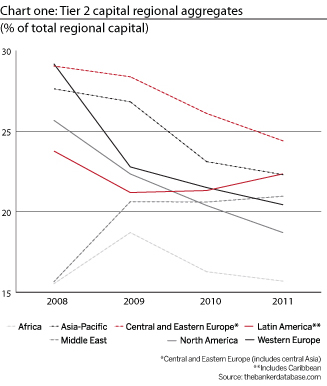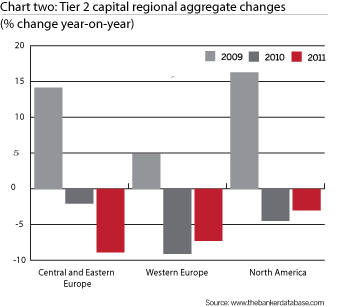One of the major conclusions drawn by regulators in the wake of the 2008 financial crisis was that Tier 2 capital, mostly in the form of hybrid bonds, was inadequate in terms of its ability to absorb losses while keeping a bank viable. Most of it consisted of what the UK Financial Services Authority dubbed “gone concern capital”, on which coupons could only be cancelled if the institution was entering insolvency.
In a bid to reduce the risk of governments being called on to bail out the banks, regulators focused instead on building up banks’ Tier 1 capital. Inevitably, this has led to a substantial squeeze in the proportion of Tier 2 capital in banks’ total capital base.
The most striking decline is in western Europe, the region that previously made greatest use of Tier 2. From almost 30% of total capital in 2008, Tier 2 had dropped to just over 20% by 2011. North America makes even less use of Tier 2, at about 19% by 2011. Only Africa is more dependent than North America on Tier 1, constant at just above 84% of the total over the past four years. It is possible that the combination of frontier markets and a complex asset class has simply been too much to enable extensive use of Tier 2.
The Middle East is the striking exception to the rule, with Tier 2 rising significantly in the total capital structure over the past four years. The region was in line with Africa in its very conservative use of Tier 2 in 2008, but now surpasses Europe or North America, at fractionally less than 21%.
The change in capital structures is not simply a reflection of a huge boost in Tier 1 capital since the crisis. Instead, in several regions there has also been active destruction of Tier 2 capital (see chart one), as banks exchange Tier 2 for Tier 1 hybrids or even common equity.
Regulators may not mourn the passing of Tier 2, but shareholders undoubtedly will. Tier 2 is a cheaper way to capitalise a bank, and the focus on Tier 1 will make it even more challenging for bank management to achieve return-on-equity targets in the future. If banks can navigate through the new regulatory capital definitions, Tier 2 may yet stage a comeback.








